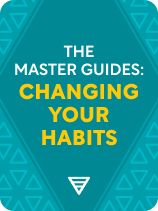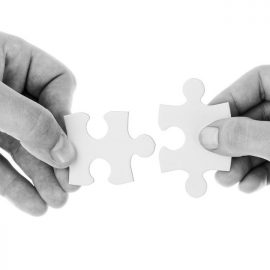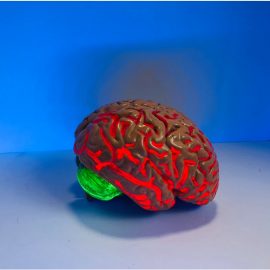

This article is an excerpt from the Shortform book guide to "The Master Guides: Changing Your Habits" by Shortform. Shortform has the world's best summaries and analyses of books you should be reading.
Like this article? Sign up for a free trial here.
How does a habit loop start? How can you make a good habit stick in the loop?
According to Charles Duhigg, the habit loop is a neurological loop that causes habits to develop and stick. It consists of three parts: the cue, routine, and reward.
Continue reading to learn how the habit loop works and how to stop it.
The Cue
The cue is what starts the habit loop. Cues are also called “prompts” or “triggers.” They can be either external (something in your environment) or internal (your thoughts or emotions). For example, say you have a habit of drinking coffee in the morning. This habit might have an external cue, such as the smell of coffee from other coffee drinkers in the office. Or it might have an internal cue, such as feeling drowsy in the morning.
The Routine
The routine is what you do automatically when the program in your brain runs. In our coffee example, the routine might consist of getting your coffee cup, going to the coffee maker in the break room, and pouring yourself a cup of coffee.
The Reward
The reward is a positive sensation that your brain associates with the routine or with completing the routine. The reward gives your brain a reason to execute the routine. It could be a pleasurable experience, or it could be relief from something negative such as pain or fear. Either way, to be part of the habit, the reward must be immediate. This is because your brain processes things that happen later on separately from the habit “program,” even if they’re direct consequences of the routine. So behaviors that generate immediate pleasure or relief but have negative long-term consequences lead to bad habits.
For example, if you drink a cup of coffee and it immediately makes you feel more alert and energetic, this will reinforce your coffee-drinking habit. On the other hand, suppose you try to address your fatigue problem a different way: You work through lunch so you can go home an hour earlier and get an extra hour of sleep. The extra sleep makes you feel more alert and energetic the next day. The reward is the same, but the delay between the routine of working through lunch and the reward of getting an extra hour of sleep is probably too long for it to make working through your lunch break habit-forming.
According to Nir Eyal, the reward must also be variable—in other words, it shouldn’t be predictable. This is especially true for rewards that suffer from diminishing returns, meaning they’re less rewarding the more times you receive them. For example, suppose you have a phone app that displays a joke whenever you open it. If it always gives you the same joke, the app probably won’t be habit-forming because there are rapidly diminishing returns to hearing the same joke over and over. But if it displays a different joke each time you click on it (a variable reward), then the app is more likely to be habit-forming.
On the other hand, a reward like relief from fear or discomfort remains potent every time the fear or discomfort is present, so you don’t need to vary it.
How to Escape the Bad Habit Loop
According to Duhigg, the key to making a new habit stick is to make the cue unmistakable and the craving as strong as possible. For example, if you want to make a habit of going for a run every morning, you could leave your running shoes in the middle of the doorway, where you’ll have to step over them to leave your bedroom in the morning. He says you can intensify the craving by intentionally anticipating the reward. Fantasize about how good you’ll feel after your run and about being in better shape because of your daily running routine.
Conversely, Duhigg says the way to break bad habits is to eliminate either the cue, the craving, or both. To do this, first, you need to identify the parts of the habit you want to change. He notes that this is sometimes difficult because you may not be conscious of what triggers you to perform a certain habit routine, or what it is about doing it that you find pleasurable.
Fully understanding the routine can help you get a better idea of what the reward might be, so he recommends writing down the exact sequence of actions you perform when you act out your habit. Then, start experimenting on yourself. Whenever you catch yourself starting to perform the routine, make a point of doing something differently, and see how you feel afterward. This information can help you determine what the reward really is. Sometimes you can eliminate your craving for something you want to quit by finding a better way to get the same reward.
For example, if you have a habit of walking to the cafeteria on your morning break and getting a soda, try walking somewhere else instead, or try getting something different at the cafeteria. Maybe you’ll find that getting up and walking around on your break is what your body really craves to relieve the discomfort of sitting at your desk all morning. Or maybe you’ll find that you’re just thirsty, and getting some water satisfies your craving as much as a soda.
Similarly, if the cue isn’t obvious, start keeping track of when and where you acted out your habit, what was happening around you, and what you were thinking or feeling at the time. If you can identify the cues that trigger an undesirable behavior, you may be able to eliminate the behavior simply by avoiding the cues.

———End of Preview———
Like what you just read? Read the rest of the world's best book summary and analysis of Shortform's "The Master Guides: Changing Your Habits" at Shortform.
Here's what you'll find in our full The Master Guides: Changing Your Habits summary:
- How even the smallest habit improvements can have a big impact on your life
- Advice from the top five best-selling authors on changing your habits
- How to identify the behaviors that keep you stuck in the same patterns






